Higgins R.A. Engineering Metallurgy: Applied Physical Metallurgy
Подождите немного. Документ загружается.

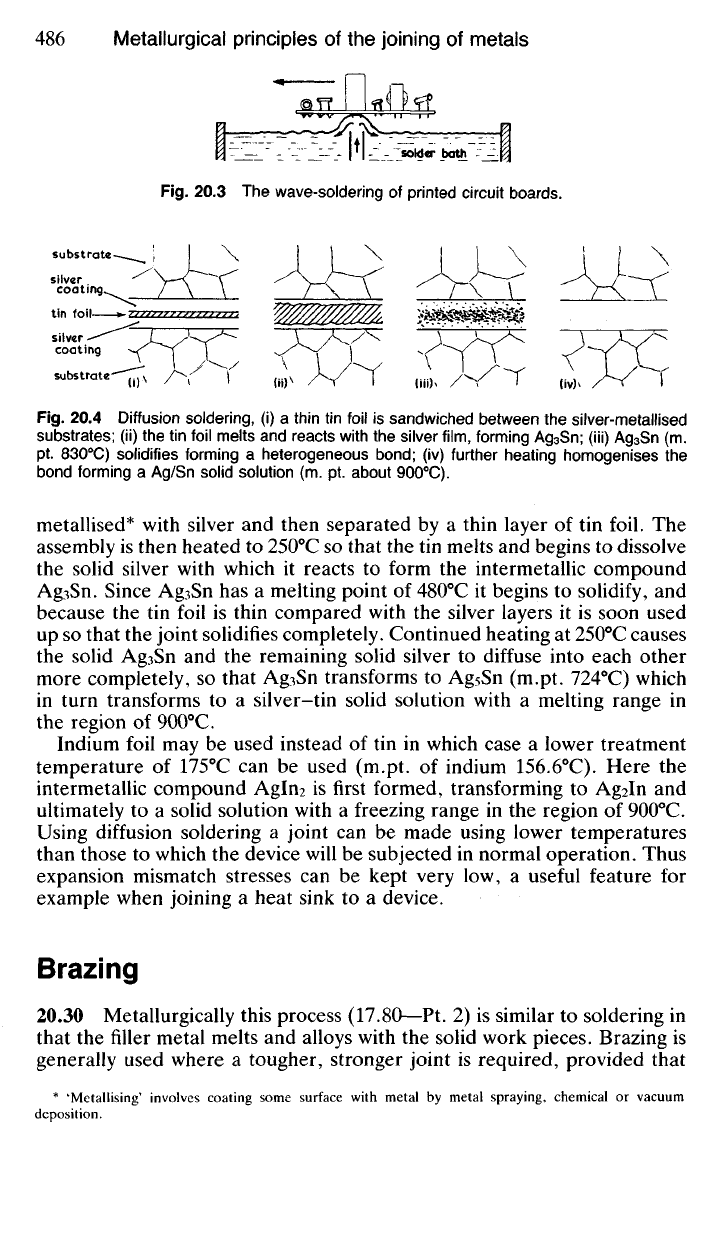
Fig.
20.4 Diffusion soldering, (i) a thin tin foil is sandwiched between the silver-metallised
substrates; (ii) the tin foil melts and reacts with the silver
film,
forming Ag
3
Sn; (iii) Ag
3
Sn (m.
pt. 830
0
C) solidifies forming a heterogeneous bond; (iv) further heating homogenises the
bond forming a Ag/Sn solid solution (m. pt. about 900
0
C).
metallised* with silver and then separated by a thin layer of tin foil. The
assembly is then heated to 250
0
C so that the tin melts and begins to dissolve
the solid silver with which it reacts to form the intermetallic compound
Ag
3
Sn. Since Ag
3
Sn has a melting point of 480
0
C it begins to solidify, and
because the tin foil is thin compared with the silver layers it is soon used
up so that the joint solidifies completely. Continued heating at 250
0
C causes
the solid Ag
3
Sn and the remaining solid silver to diffuse into each other
more completely, so that Ag
3
Sn transforms to Ag
5
Sn (m.pt. 724°C) which
in turn transforms to a silver-tin solid solution with a melting range in
the region of 900
0
C.
Indium foil may be used instead of tin in which case a lower treatment
temperature of 175°C can be used (m.pt. of indium 156.6
0
C). Here the
intermetallic compound AgIn
2
is first formed, transforming to Ag
2
In and
ultimately to a solid solution with a freezing range in the region of 900
0
C.
Using diffusion soldering a joint can be made using lower temperatures
than those to which the device will be subjected in normal operation. Thus
expansion mismatch stresses can be kept very low, a useful feature for
example when joining a heat sink to a device.
Brazing
20.30 Metallurgically this process (17.80—Pt. 2) is similar to soldering in
that the filler metal melts and alloys with the solid work pieces. Brazing is
generally used where a tougher, stronger joint is required, provided that
* 'Metallising' involves coating some surface with metal by metal spraying, chemical or vacuum
deposition.
Fig.
20.3 The wave-soldering of printed circuit boards.
solder bath
substrate-
silver
coating
tin foil
silver
coating
substrate
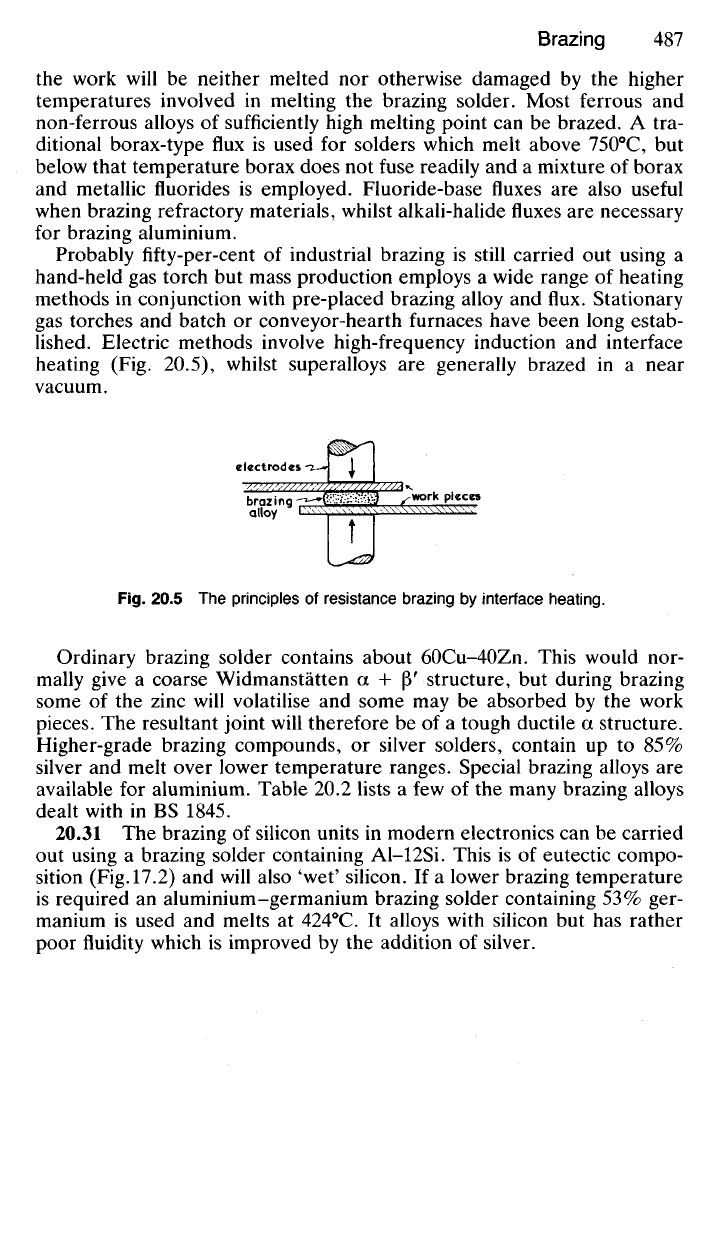
the work will be neither melted nor otherwise damaged by the higher
temperatures involved in melting the brazing solder. Most ferrous and
non-ferrous alloys of sufficiently high melting point can be brazed. A tra-
ditional borax-type flux is used for solders which melt above 750
0
C, but
below that temperature borax does not fuse readily and a mixture of borax
and metallic fluorides is employed. Fluoride-base fluxes are also useful
when brazing refractory materials, whilst alkali-halide fluxes are necessary
for brazing aluminium.
Probably fifty-per-cent of industrial brazing is still carried out using a
hand-held gas torch but mass production employs a wide range of heating
methods in conjunction with pre-placed brazing alloy and flux. Stationary
gas torches and batch or conveyor-hearth furnaces have been long estab-
lished. Electric methods involve high-frequency induction and interface
heating (Fig. 20.5), whilst superalloys are generally brazed in a near
vacuum.
Fig.
20.5 The principles of resistance brazing by interface heating.
Ordinary brazing solder contains about 60Cu-40Zn. This would nor-
mally give a coarse Widmanstatten a + |3' structure, but during brazing
some of the zinc will volatilise and some may be absorbed by the work
pieces. The resultant joint will therefore be of a tough ductile a structure.
Higher-grade brazing compounds, or silver solders, contain up to 85%
silver and melt over lower temperature ranges. Special brazing alloys are
available for aluminium. Table 20.2 lists a few of the many brazing alloys
dealt with in BS 1845.
20.31 The brazing of silicon units in modern electronics can be carried
out using a brazing solder containing A1-12SL This is of eutectic compo-
sition (Fig. 17.2) and will also 'wet' silicon. If a lower brazing temperature
is required an aluminium-germanium brazing solder containing 53% ger-
manium is used and melts at 424°C. It alloys with silicon but has rather
poor fluidity which is improved by the addition of silver.
electrodes
brazing
alloy
work pieces
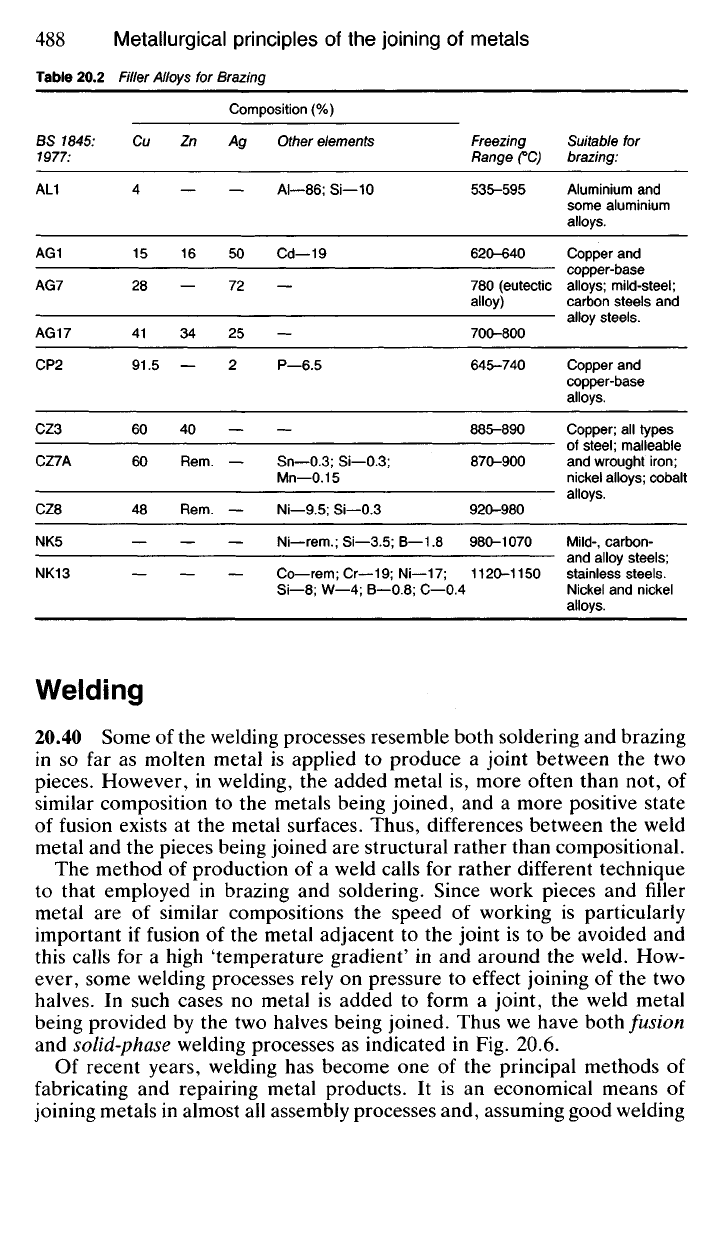
Table 20.2 Filler Alloys for Brazing
Composition (%)
BS 1845:
1977:
AL1
AG1
AG7
AG17
CP2
CZ3
CZ7A
CZ8
NK5
NK13
Cu
4
15
28
41
91.5
60
60
48
Zn
16
34
40
Rem.
Rem.
Ag
50
72
25
2
Other elements
Al-86;
Si—10
Cd-19
P—6.5
Sn-0.3;
Si—0.3;
Mn-0.15
Ni-9.5; Si—0.3
Ni-rem.;
Si—3.5; B—1.8
Co—rem;
Cr—19; Ni—17;
Si—8;
W—4; B—0.8;
C—0.4
Freezing
Range CC)
535-595
620-640
780 (eutectic
alloy)
700-800
645-740
885-890
870-900
920-980
980-1070
1120-1150
Suitable for
brazing:
Aluminium and
some aluminium
alloys.
Copper and
copper-base
alloys;
mild-steel;
carbon steels and
alloy steels.
Copper and
copper-base
alloys.
Copper; all types
of steel; malleable
and wrought
iron;
nickel alloys; cobalt
alloys.
MiId-,
carbon-
and alloy steels;
stainless steels.
Nickel and nickel
alloys.
Welding
20.40 Some of the welding processes resemble both soldering and brazing
in so far as molten metal is applied to produce a joint between the two
pieces. However, in welding, the added metal is, more often than not, of
similar composition to the metals being joined, and a more positive state
of fusion exists at the metal surfaces. Thus, differences between the weld
metal and the pieces being joined are structural rather than compositional.
The method of production of a weld calls for rather different technique
to that employed in brazing and soldering. Since work pieces and filler
metal are of similar compositions the speed of working is particularly
important if fusion of the metal adjacent to the joint is to be avoided and
this calls for a high 'temperature gradient' in and around the weld. How-
ever, some welding processes rely on pressure to effect joining of the two
halves. In such cases no metal is added to form a joint, the weld metal
being provided by the two halves being joined. Thus we have both fusion
and solid-phase welding processes as indicated in Fig. 20.6.
Of recent years, welding has become one of the principal methods of
fabricating and repairing metal products. It is an economical means of
joining metals in almost all assembly processes and, assuming good welding
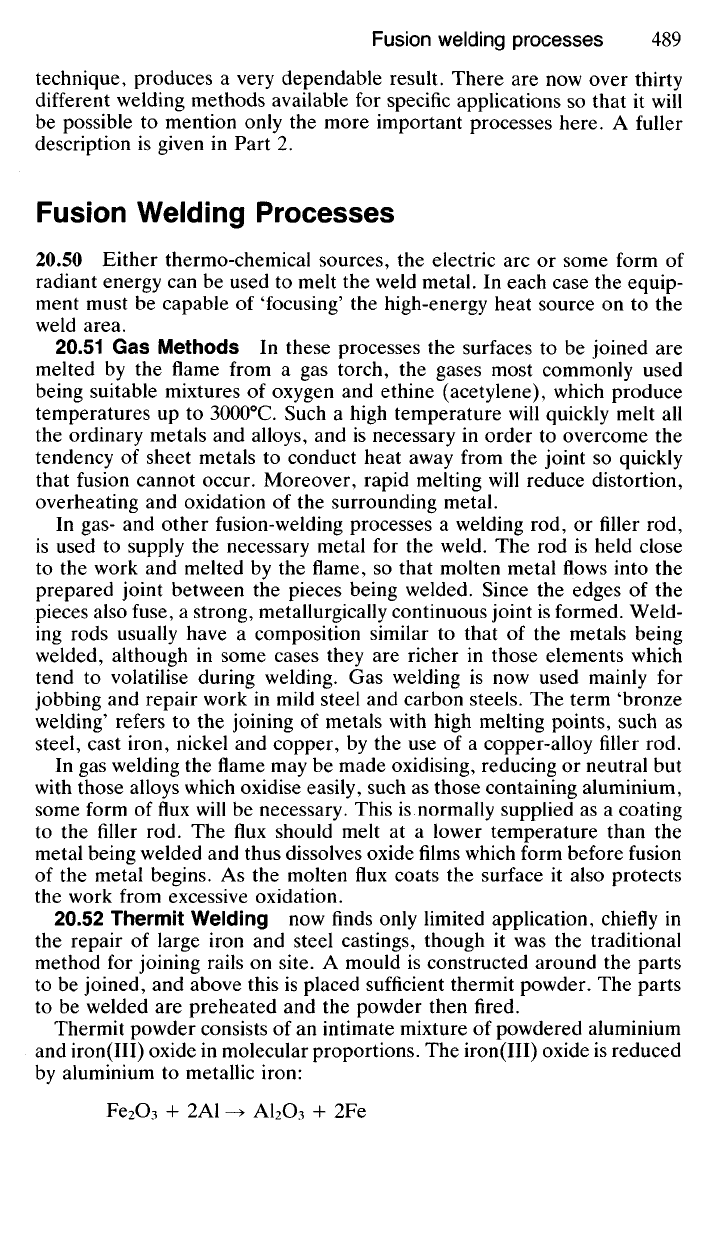
technique, produces a very dependable result. There are now over thirty
different welding methods available for specific applications so that it will
be possible to mention only the more important processes here. A fuller
description is given in Part 2.
Fusion Welding Processes
20.50 Either thermo-chemical sources, the electric arc or some form of
radiant energy can be used to melt the weld metal. In each case the equip-
ment must be capable of 'focusing' the high-energy heat source on to the
weld area.
20.51 Gas Methods In these processes the surfaces to be joined are
melted by the flame from a gas torch, the gases most commonly used
being suitable mixtures of oxygen and ethine (acetylene), which produce
temperatures up to 3000
0
C. Such a high temperature will quickly melt all
the ordinary metals and alloys, and is necessary in order to overcome the
tendency of sheet metals to conduct heat away from the joint so quickly
that fusion cannot occur. Moreover, rapid melting will reduce distortion,
overheating and oxidation of the surrounding metal.
In gas- and other fusion-welding processes a welding rod, or filler rod,
is used to supply the necessary metal for the weld. The rod is held close
to the work and melted by the flame, so that molten metal flows into the
prepared joint between the pieces being welded. Since the edges of the
pieces also fuse, a strong, metallurgically continuous joint is formed. Weld-
ing rods usually have a composition similar to that of the metals being
welded, although in some cases they are richer in those elements which
tend to volatilise during welding. Gas welding is now used mainly for
jobbing and repair work in mild steel and carbon steels. The term 'bronze
welding' refers to the joining of metals with high melting points, such as
steel, cast iron, nickel and copper, by the use of a copper-alloy filler rod.
In gas welding the flame may be made oxidising, reducing or neutral but
with those alloys which oxidise easily, such as those containing aluminium,
some form of flux will be necessary. This is normally supplied as a coating
to the filler rod. The flux should melt at a lower temperature than the
metal being welded and thus dissolves oxide films which form before fusion
of the metal begins. As the molten flux coats the surface it also protects
the work from excessive oxidation.
20.52 Thermit Welding now finds only limited application, chiefly in
the repair of large iron and steel castings, though it was the traditional
method for joining rails on site. A mould is constructed around the parts
to be joined, and above this is placed sufficient thermit powder. The parts
to be welded are preheated and the powder then fired.
Thermit powder consists of an intimate mixture of powdered aluminium
and iron(III) oxide in molecular proportions. The iron(III) oxide is reduced
by aluminium to metallic iron:
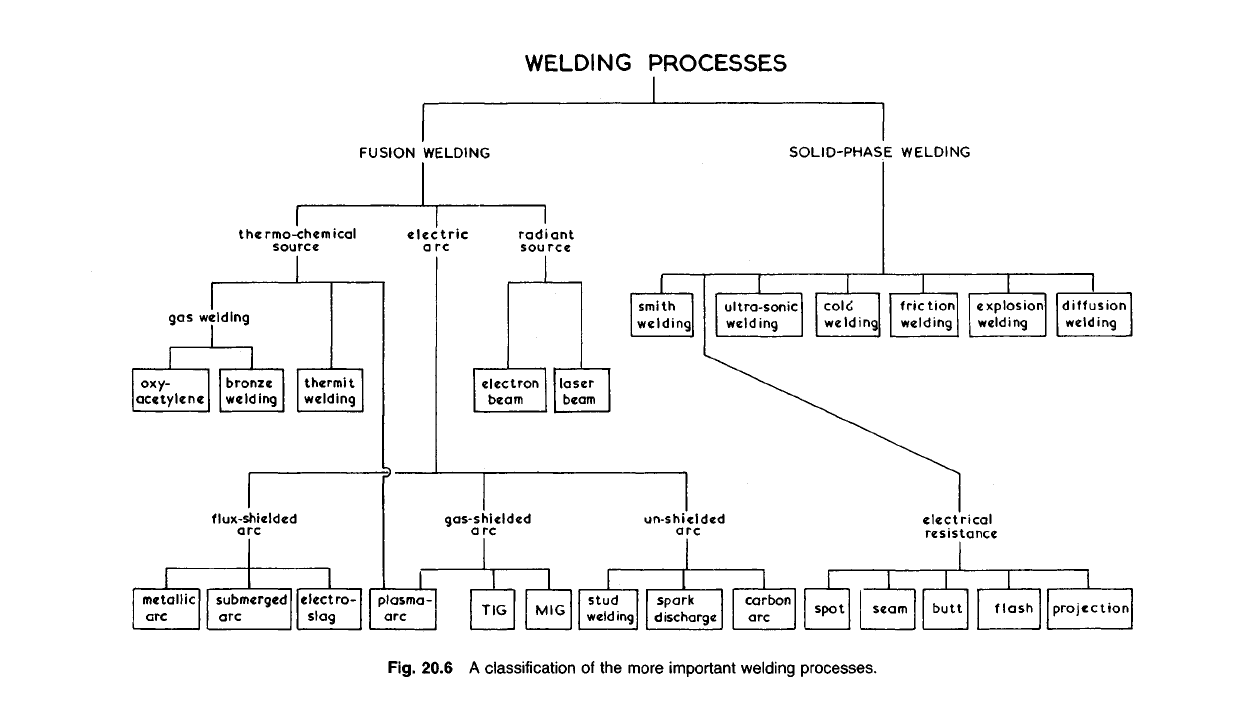
Fig. 20.6 A
classification
of the
more
important
welding
processes.
WELDING
PROCESSES
SOLID-PHASE
WELDING
electrical
resistance
un-shielded
arc
radiant
sou
rce
FUSION
WELDING
electric
arc
thermo-chemical
source
gas
welding
flux-shielded
arc
gas-shielded
arc
laser
beam
electron
beam
thermit
welding
bronze
welding
ox
y-
acetylene
smith
welding
ultra-sonic
welding
cole:
welding
friction
welding
explosion
welding
diffusion
welding
projection
flash
butt
seam
spot
carbon
arc
spark
discharge
stud
welding
MIGTIG
plasma-
arc
electro-
slag
submerged
arc
metallic
arc
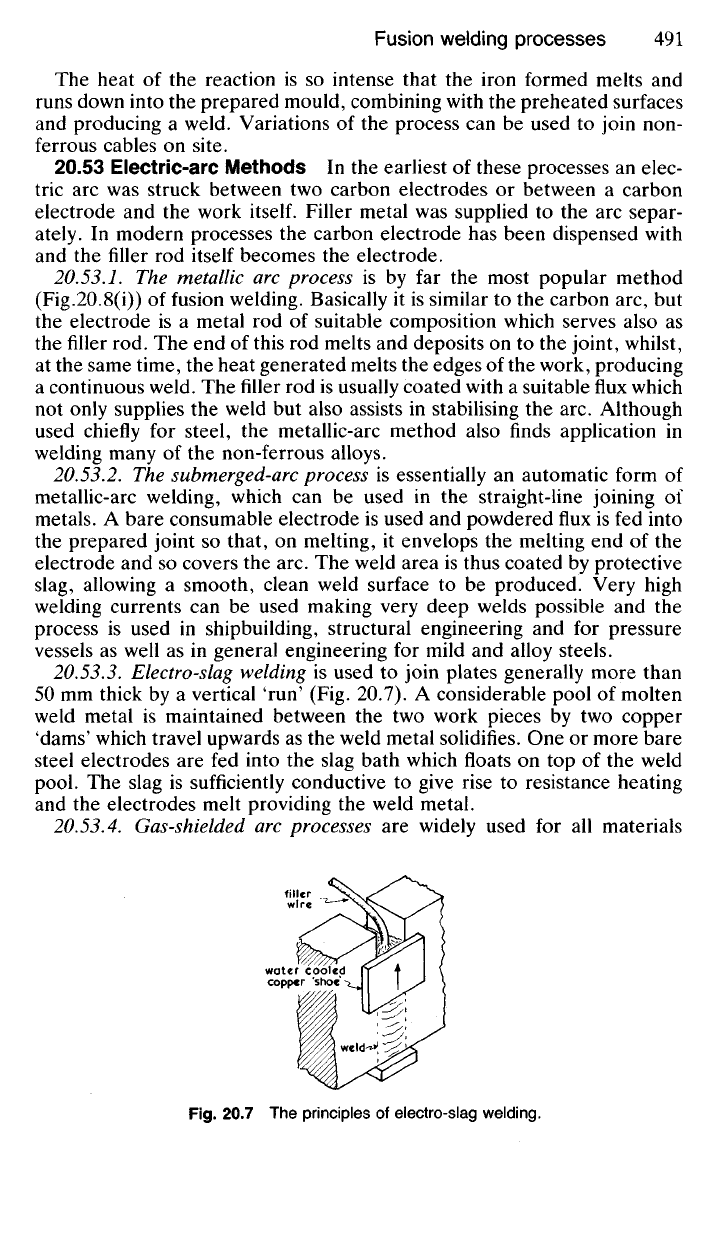
The heat of the reaction is so intense that the iron formed melts and
runs down into the prepared mould, combining with the preheated surfaces
and producing a weld. Variations of the process can be used to join non-
ferrous cables on site.
20.53 Electric-arc Methods In the earliest of these processes an elec-
tric arc was struck between two carbon electrodes or between a carbon
electrode and the work
itself.
Filler metal was supplied to the arc separ-
ately. In modern processes the carbon electrode has been dispensed with
and the filler rod itself becomes the electrode.
20.53.1.
The metallic arc process is by far the most popular method
(Fig.20.8(i)) of fusion welding. Basically it is similar to the carbon arc, but
the electrode is a metal rod of suitable composition which serves also as
the filler rod. The end of this rod melts and deposits on to the joint, whilst,
at the same time, the heat generated melts the edges of the work, producing
a continuous weld. The filler rod is usually coated with a suitable flux which
not only supplies the weld but also assists in stabilising the arc. Although
used chiefly for steel, the metallic-arc method also finds application in
welding many of the non-ferrous alloys.
20.53.2. The submerged-arc process is essentially an automatic form of
metallic-arc welding, which can be used in the straight-line joining of
metals. A bare consumable electrode is used and powdered flux is fed into
the prepared joint so that, on melting, it envelops the melting end of the
electrode and so covers the arc. The weld area is thus coated by protective
slag, allowing a smooth, clean weld surface to be produced. Very high
welding currents can be used making very deep welds possible and the
process is used in shipbuilding, structural engineering and for pressure
vessels as well as in general engineering for mild and alloy steels.
20.53.3.
Electro-slag welding is used to join plates generally more than
50 mm thick by a vertical 'run' (Fig. 20.7). A considerable pool of molten
weld metal is maintained between the two work pieces by two copper
'dams'
which travel upwards as the weld metal solidifies. One or more bare
steel electrodes are fed into the slag bath which floats on top of the weld
pool. The slag is sufficiently conductive to give rise to resistance heating
and the electrodes melt providing the weld metal.
20.53.4. Gas-shielded arc processes are widely used for all materials
Fig.
20.7 The principles of electro-slag welding.
filler
wire
water cooled
copper shoe*
weld
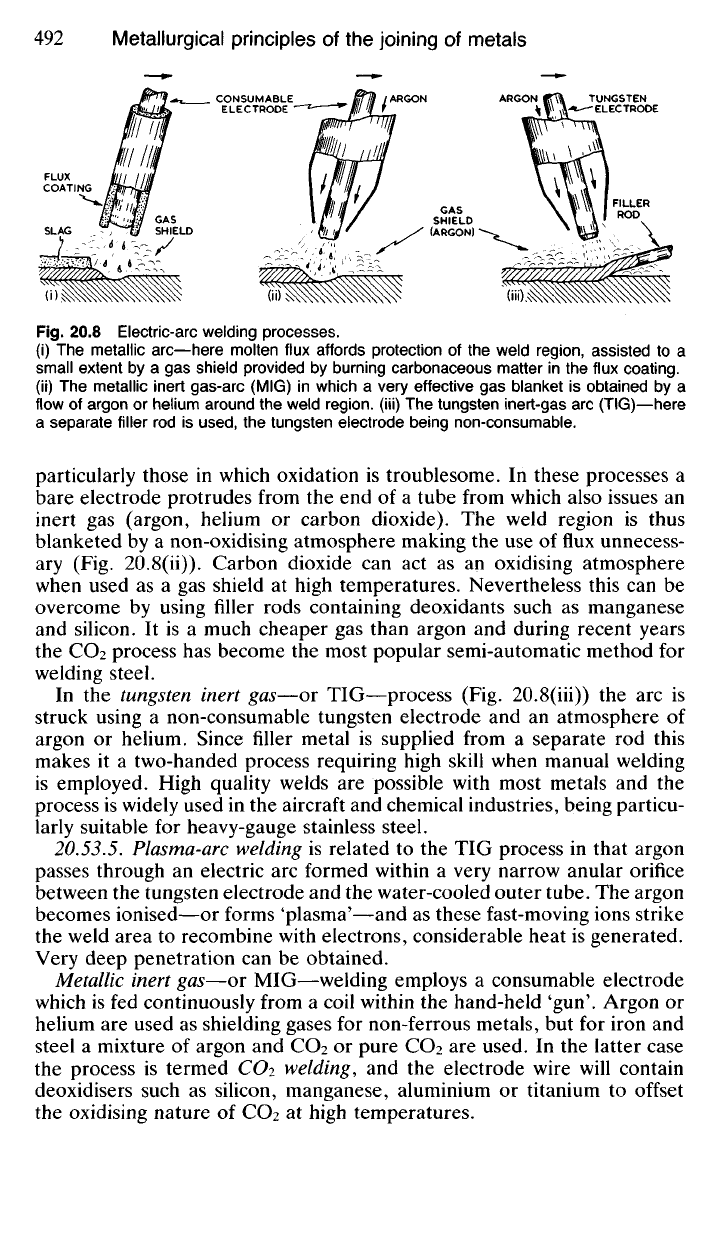
Fig.
20.8 Electric-arc welding processes.
(i) The metallic arc—here molten flux affords protection of the weld region, assisted to a
small extent by a gas shield provided by burning carbonaceous matter in the flux coating,
(ii) The metallic inert gas-arc (MIG) in which a very effective gas blanket is obtained by a
flow of argon or helium around the weld region, (iii) The tungsten inert-gas arc (TIG)—here
a separate filler rod is used, the tungsten electrode being non-consumable.
particularly those in which oxidation is troublesome. In these processes a
bare electrode protrudes from the end of a tube from which also issues an
inert gas (argon, helium or carbon dioxide). The weld region is thus
blanketed by a non-oxidising atmosphere making the use of flux unnecess-
ary (Fig. 20.8(ii)). Carbon dioxide can act as an oxidising atmosphere
when used as a gas shield at high temperatures. Nevertheless this can be
overcome by using filler rods containing deoxidants such as manganese
and silicon. It is a much cheaper gas than argon and during recent years
the CO2 process has become the most popular semi-automatic method for
welding steel.
In the tungsten inert gas—or TIG—process (Fig. 20.8(iii)) the arc is
struck using a non-consumable tungsten electrode and an atmosphere of
argon or helium. Since filler metal is supplied from a separate rod this
makes it a two-handed process requiring high skill when manual welding
is employed. High quality welds are possible with most metals and the
process is widely used in the aircraft and chemical industries, being particu-
larly suitable for heavy-gauge stainless steel.
20.53.5. Plasma-arc welding is related to the TIG process in that argon
passes through an electric arc formed within a very narrow anular orifice
between the tungsten electrode and the water-cooled outer tube. The argon
becomes ionised—or forms 'plasma'—and as these fast-moving ions strike
the weld area to recombine with electrons, considerable heat is generated.
Very deep penetration can be obtained.
Metallic inert gas—or MIG—welding employs a consumable electrode
which is fed continuously from a coil within the hand-held 'gun'. Argon or
helium are used as shielding gases for non-ferrous metals, but for iron and
steel a mixture of argon and CO2 or pure CO2 are used. In the latter case
the process is termed CO2 welding, and the electrode wire will contain
deoxidisers such as silicon, manganese, aluminium or titanium to offset
the oxidising nature of CO2 at high temperatures.
FLUX
COATING
SLAG
GAS
SHIELD
CONSUMABLE
ELECTRODE
ARGON
GAS
SHIELD
(ARGON)
TUNGSTEN
ELECTRODE
ARGON
FILLER
ROD
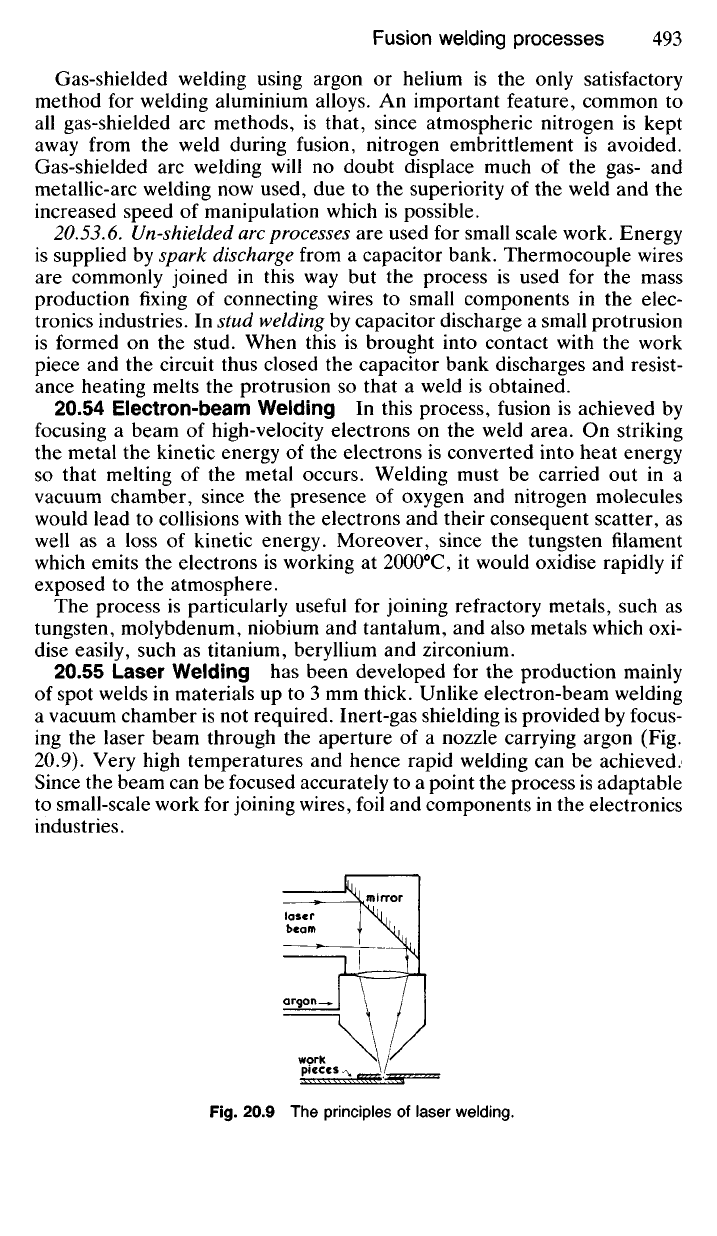
Gas-shielded welding using argon or helium is the only satisfactory
method for welding aluminium alloys. An important feature, common to
all gas-shielded arc methods, is that, since atmospheric nitrogen is kept
away from the weld during fusion, nitrogen embrittlement is avoided.
Gas-shielded arc welding will no doubt displace much of the gas- and
metallic-arc welding now used, due to the superiority of the weld and the
increased speed of manipulation which is possible.
20.53.6. Unshielded arc
processes
are used for small scale work. Energy
is supplied by spark
discharge
from a capacitor bank. Thermocouple wires
are commonly joined in this way but the process is used for the mass
production fixing of connecting wires to small components in the elec-
tronics industries. In stud welding by capacitor discharge a small protrusion
is formed on the stud. When this is brought into contact with the work
piece and the circuit thus closed the capacitor bank discharges and resist-
ance heating melts the protrusion so that a weld is obtained.
20.54 Electron-beam Welding In this process, fusion is achieved by
focusing a beam of high-velocity electrons on the weld area. On striking
the metal the kinetic energy of the electrons is converted into heat energy
so that melting of the metal occurs. Welding must be carried out in a
vacuum chamber, since the presence of oxygen and nitrogen molecules
would lead to collisions with the electrons and their consequent scatter, as
well as a loss of kinetic energy. Moreover, since the tungsten filament
which emits the electrons is working at 2000
0
C, it would oxidise rapidly if
exposed to the atmosphere.
The process is particularly useful for joining refractory metals, such as
tungsten, molybdenum, niobium and tantalum, and also metals which oxi-
dise easily, such as titanium, beryllium and zirconium.
20.55 Laser Welding has been developed for the production mainly
of spot welds in materials up to 3 mm thick. Unlike electron-beam welding
a vacuum chamber is not required. Inert-gas shielding is provided by focus-
ing the laser beam through the aperture of a nozzle carrying argon (Fig.
20.9).
Very high temperatures and hence rapid welding can be achieved.
Since the beam can be focused accurately to a point the process is adaptable
to small-scale work for joining wires, foil and components in the electronics
industries.
Fig.
20.9 The principles of laser welding.
work
pieces
argon
laser
beam
mirror
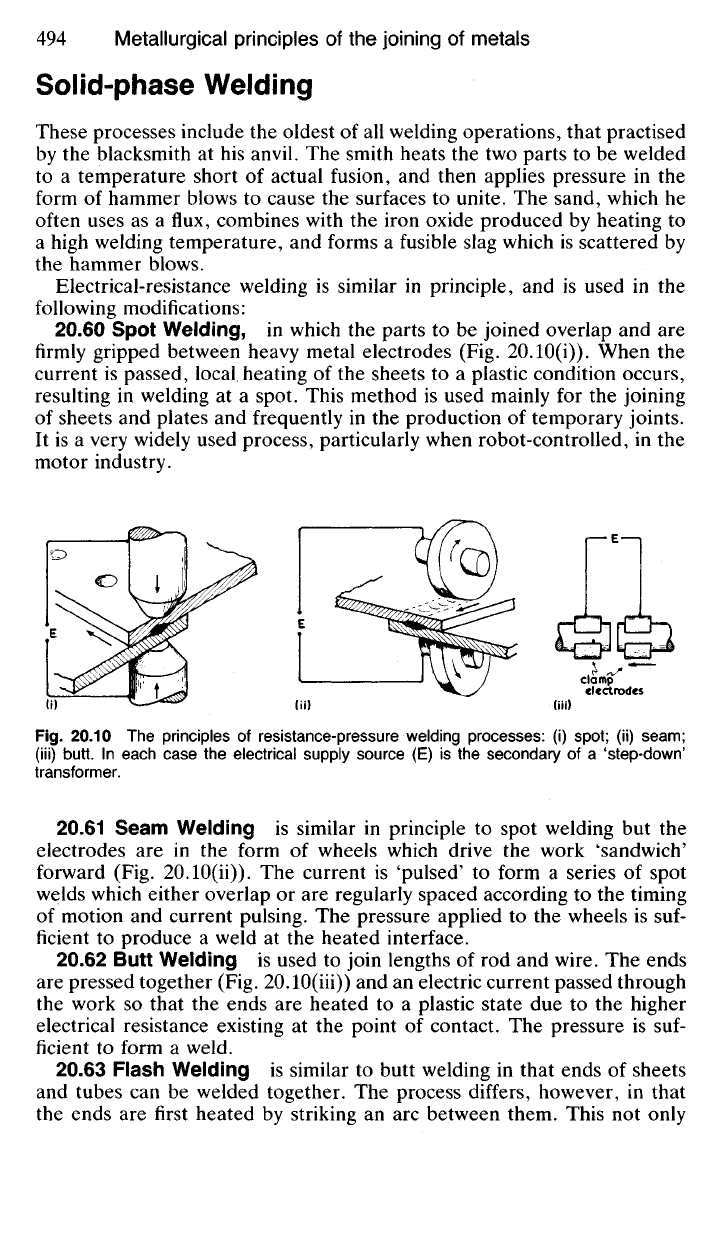
Solid-phase Welding
These processes include the oldest of all welding operations, that practised
by the blacksmith at his anvil. The smith heats the two parts to be welded
to a temperature short of actual fusion, and then applies pressure in the
form of hammer blows to cause the surfaces to unite. The sand, which he
often uses as a flux, combines with the iron oxide produced by heating to
a high welding temperature, and forms a fusible slag which is scattered by
the hammer blows.
Electrical-resistance welding is similar in principle, and is used in the
following modifications:
20.60 Spot Welding, in which the parts to be joined overlap and are
firmly gripped between heavy metal electrodes (Fig. 20.10(i)). When the
current is passed, local heating of the sheets to a plastic condition occurs,
resulting in welding at a spot. This method is used mainly for the joining
of sheets and plates and frequently in the production of temporary joints.
It is a very widely used process, particularly when robot-controlled, in the
motor industry.
Fig.
20.10 The principles of resistance-pressure welding processes: (i) spot; (ii) seam;
(iii) butt. In each case the electrical supply source (E) is the secondary of a 'step-down'
transformer.
20.61 Seam Welding is similar in principle to spot welding but the
electrodes are in the form of wheels which drive the work 'sandwich'
forward (Fig. 20.10(ii)). The current is 'pulsed' to form a series of spot
welds which either overlap or are regularly spaced according to the timing
of motion and current pulsing. The pressure applied to the wheels is suf-
ficient to produce a weld at the heated interface.
20.62 Butt Welding is used to join lengths of rod and wire. The ends
are pressed together (Fig. 20.10(iii)) and an electric current passed through
the work so that the ends are heated to a plastic state due to the higher
electrical resistance existing at the point of contact. The pressure is suf-
ficient to form a weld.
20.63 Flash Welding is similar to butt welding in that ends of sheets
and tubes can be welded together. The process differs, however, in that
the ends are first heated by striking an arc between them. This not only
damp
electrodes
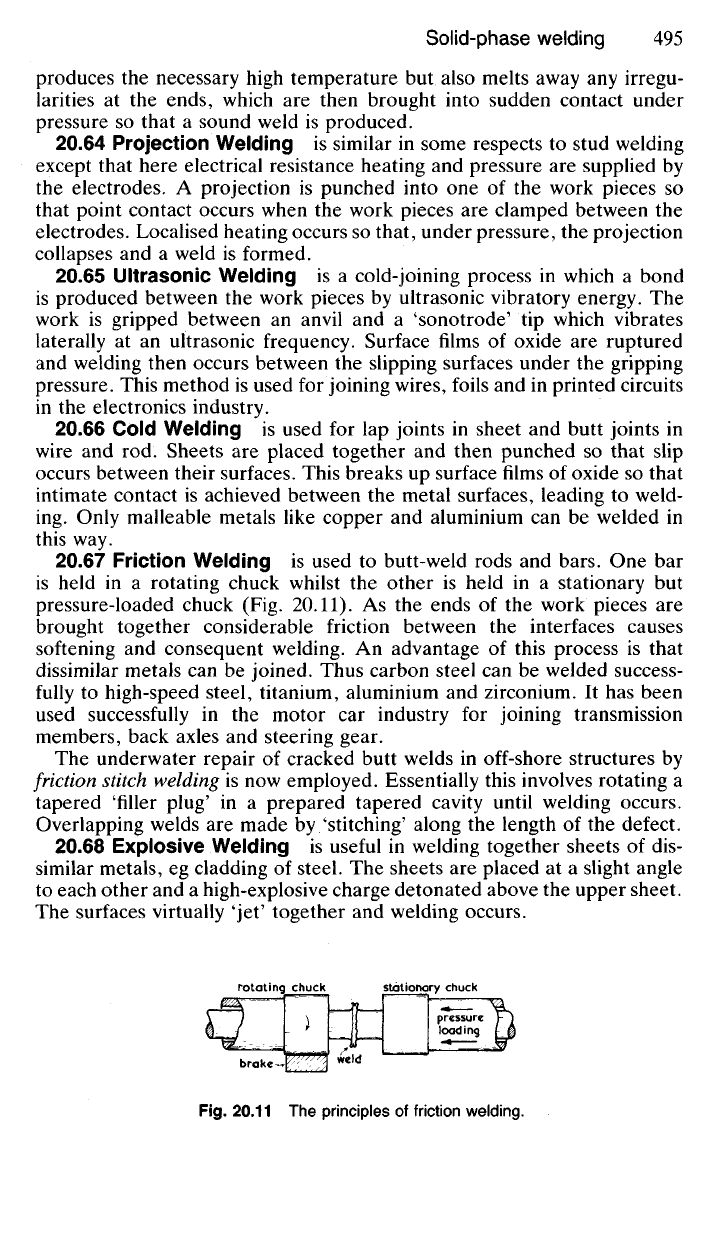
produces
the
necessary high temperature
but
also melts away
any
irregu-
larities
at the
ends, which
are
then brought into sudden contact under
pressure
so
that
a
sound weld
is
produced.
20.64 Projection Welding
is
similar
in
some respects
to
stud welding
except that here electrical resistance heating
and
pressure
are
supplied
by
the electrodes.
A
projection
is
punched into
one of the
work pieces
so
that point contact occurs when
the
work pieces
are
clamped between
the
electrodes. Localised heating occurs
so
that, under pressure,
the
projection
collapses
and a
weld
is
formed.
20.65 Ultrasonic Welding
is a
cold-joining process
in
which
a
bond
is produced between
the
work pieces
by
ultrasonic vibratory energy.
The
work
is
gripped between
an
anvil
and a
'sonotrode'
tip
which vibrates
laterally
at an
ultrasonic frequency. Surface films
of
oxide
are
ruptured
and welding then occurs between
the
slipping surfaces under
the
gripping
pressure. This method
is
used
for
joining wires, foils
and in
printed circuits
in
the
electronics industry.
20.66 Cold Welding
is
used
for lap
joints
in
sheet
and
butt joints
in
wire
and rod.
Sheets
are
placed together
and
then punched
so
that slip
occurs between their surfaces. This breaks
up
surface films
of
oxide
so
that
intimate contact
is
achieved between
the
metal surfaces, leading
to
weld-
ing. Only malleable metals like copper
and
aluminium
can be
welded
in
this
way.
20.67 Friction Welding
is
used
to
butt-weld rods
and
bars.
One bar
is held
in a
rotating chuck whilst
the
other
is
held
in a
stationary
but
pressure-loaded chuck
(Fig.
20.11).
As the
ends
of the
work pieces
are
brought together considerable friction between
the
interfaces causes
softening
and
consequent welding.
An
advantage
of
this process
is
that
dissimilar metals
can be
joined. Thus carbon steel
can be
welded success-
fully
to
high-speed steel, titanium, aluminium
and
zirconium.
It has
been
used successfully
in the
motor
car
industry
for
joining transmission
members, back axles
and
steering gear.
The underwater repair
of
cracked butt welds
in
off-shore structures
by
friction stitch welding
is
now
employed. Essentially this involves rotating
a
tapered 'filler plug'
in a
prepared tapered cavity until welding occurs.
Overlapping welds
are
made
by
/stitching' along
the
length
of the
defect.
20.68 Explosive Welding
is
useful
in
welding together sheets
of dis-
similar metals,
eg
cladding
of
steel.
The
sheets
are
placed
at a
slight angle
to each other
and
a
high-explosive charge detonated above
the
upper sheet.
The surfaces virtually
'jet'
together
and
welding occurs.
Fig.
20.11 The principles of friction welding.
stationary chuckrotating chuck
pressure
loading
brake
weld
